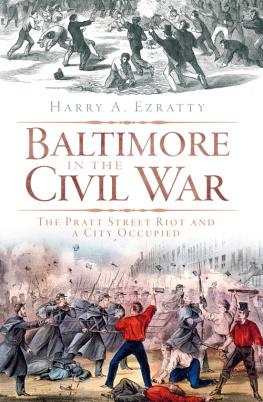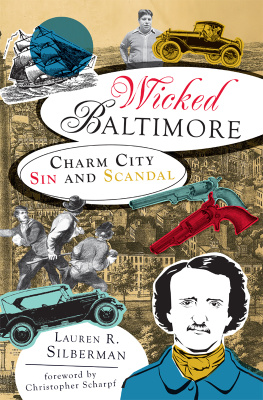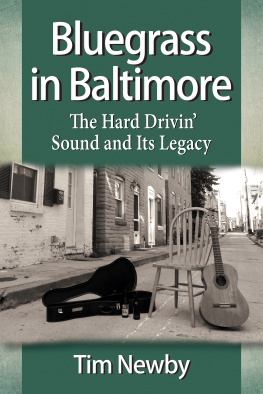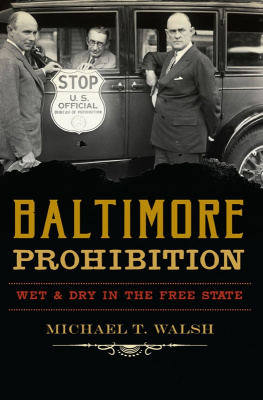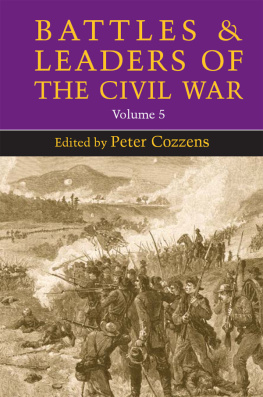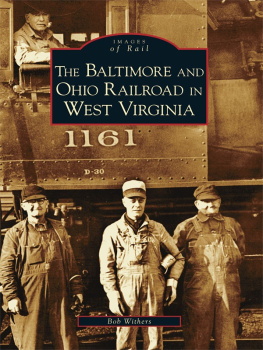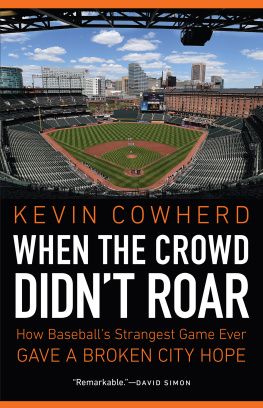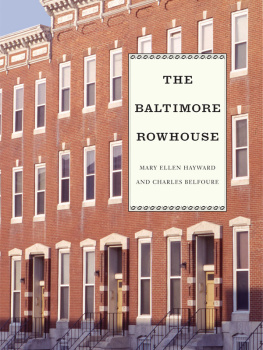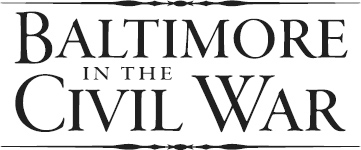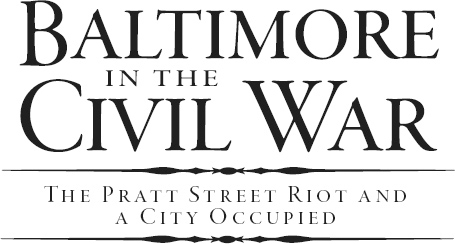H ARRY A. E ZRATTY
Published by The History Press
Charleston, SC 29403
www.historypress.net
Copyright 2010 by Harry A. Ezratty
All rights reserved
Cover images: Courtesy of Enoch Pratt Free Library, Marylands State Resource Center,
Baltimore, MD.
First published 2010
e-book edition 2011
ISBN 978.1.61423.007.6
Library of Congress Cataloging-in-Publication Data
Ezratty, Harry A.
Baltimore in the Civil War : the Pratt Street riot and a city occupied / Harry A. Ezratty.
p. cm.
Includes bibliographical references.
print edition: ISBN 978-1-60949-003-4
1. Baltimore (Md.)--History--Civil War, 1861-1865. 2. Riots--Maryland--Baltimore-
History--19th century. 3. Baltimore (Md.)--History--Civil War, 1861-1865--Social aspects.
4. United States--History--Civil War, 1861-1865--Social aspects. I. Title.
F189.B157E98 2010
975.2603--dc22
2010030904
Notice: The information in this book is true and complete to the best of our knowledge. It is offered without guarantee on the part of the author or The History Press. The author and The History Press disclaim all liability in connection with the use of this book.
All rights reserved. No part of this book may be reproduced or transmitted in any form whatsoever without prior written permission from the publisher except in the case of brief quotations embodied in critical articles and reviews.
To the men and the women who died in the Civil War
The Blue and the Gray: Americans all
and
To the City of Baltimore
Contents
Foreword
I ll be the first to admit that I am an unlikely person to write a foreword to a book about Baltimores Pratt Street Riot. My background is in neither U.S. Civil War nor legal history but rather the history of architecture and the built environment. While many people focus on personalities, events or political or intellectual patterns or currents, and lean on them to illuminate the past, I tend to focus on the man-made backdrop against which human events took place. It goes without saying that architecture and, more generally, the built environmentbuildings, parks, roads, bridges and other structures and placesdefine communities and give them their identities. Brantz Mayer, a prominent Baltimore-born and based historian and writer, said as much in 1848 when he remarked, on the occasion of the opening of the Baltimore Athenaeum, a leading cultural institution of its day, Architecture is the physiognomy of cities. But the built environment is more than a mere representation of communities. It is also an agent in shaping and directing human behaviors and events.
The question posed by Harry Ezratty in his preface of why some native Baltimoreans are unaware of the Pratt Street Riot and other major events in the history of Baltimore is a complicated one with many plausible answers. Students might not be learning about it in schools. Local history organizations and institutions might not be highlighting it in publications and exhibits. The tourism and promotion bureau might not be promoting it. Add to these the tendency for people to take their immediate surroundings for granted and to visit museums, parks and other cultural attractions while on vacation in other places than at home. (Transplants like Ezratty and others, myself included, who grew up somewhere else but at some point in their lives established roots in Baltimore, tend to research and explore their adopted communities more actively than the natives. Its part of the acculturation process, which for many transplants may last a lifetime.) Native Baltimoreansanyone for that matteralso might be unaware of the riot because so little of the built environment that formed the backdrop of that pivotal event in the history of the Civil War survives. The medieval idiom, Out of sight, out of mind, comes to mind. Certainly, people and events are important, but the places where history took place help cement those stories in peoples memories.
The absence of that architectural backdrop certainly helps explain the difficulty of addressing the riot and, by extension, the Civil War when teaching place-based history or the history of architecture in Baltimore. Unlike in Washington, D.C., where the construction of the dome of the U.S. Capitol continued uninterrupted throughout the Civil War, in Baltimore the construction and completion of major monuments came to a grinding halt in 1861. The Baltimore City Hallarguably the citys most important construction project of the mid-nineteenth centurygot as far as the design stage in 1860, but construction did not begin on the site until 1867, by which time both the building committee membership and architectural tastes had changed. As built, the city hall, which features mansard roofs that were in fashion in Baltimore after the Civil War, bears little resemblance to the approved antebellum design. That in and of itself is significant and worthwhile, but it represents a caesura or a breach in the history of Baltimores architecture, not a continuity or bridge across the 1860s.
The Peabody Institute, a cultural institution founded by the international financier and philanthropist George Peabody, though completed in 1861 on Baltimores Mount Vernon Place, stood dormant for the duration of the war; it finally opened its doors in 1866, five years after the building was complete. One noteworthy exception to this building bust in Baltimore was the Classical revival U.S. Courthouse built on the northwest corner of Fayette Street and Guilford Avenue between 1862 and 1865, but it did not survive beyond the 1930s.
The Civil War camps established throughout Baltimore by Union regiments in the early 1860s have long since faded into oblivion. Nothing remains of Camp Carroll at Mount Clare, the mid-eighteenth-century country estate of Charles Carroll, barrister, a distant cousin of Charles Carroll of Carrollton, a Marylander and the only Catholic signer of the Declaration of Independence. Camps Bradford and Millington, the Lafayette and Belger Barracks, the camp of the Twenty-first Indiana Regiment at Druid Hill and all the military hospitals in occupied Baltimore, some of them in purpose-built buildings and others in preexisting ones, are all gone, though the sitessome of them city parksremain.
Of course, a number of key buildings and sites in Baltimore associated with the people and events of the Civil War survive. Federal Hill, the site directly across the Basin (now the Inner Harbor) from Baltimores main wharves, where Union general Benjamin F. Butler and a Massachusetts regiment built earthworks and established a fort, is now a popular city park. Fort McHenry, now a national park and historic shrine, served as a prison where many Southern sympathizers ended up being held without charge after President Abraham Lincolns suspension of the writ of habeas corpus on April 27, 1861. However, the fort is first and foremost recognized as the birthplace of the national anthem and for its role in repelling the British and defending the city of Baltimore during the War of 1812.
Both President Street and Camden railroad stationsthe bookends of that fatal trajectory along which the Pratt Street Riot took place and people diedstill stand, though stripped of their train sheds and now serving other purposes. President Street Station is now home to the Baltimore Civil War Museum, which has struggled to survive ever since it first opened its doors in 1997. Camden Station, today an architectural pendant to Baltimores Oriole Park at Camden Yards baseball stadium, houses a sports museum.

